When your favorite thing to do at the gym is lifting weights, you may only spend a little time in the cardio section. You head over there one day and see anywhere from a few cardio machines to several rows of ellipticals, bikes, treadmills, and stair steppers.
As a strength athlete, you may seek a more high-intensity cardio workout and zero in on the last two: StairMaster versus treadmill. So, should you run or climb stairs for a better workout? It depends on your fitness goals, your body, and your preferences.
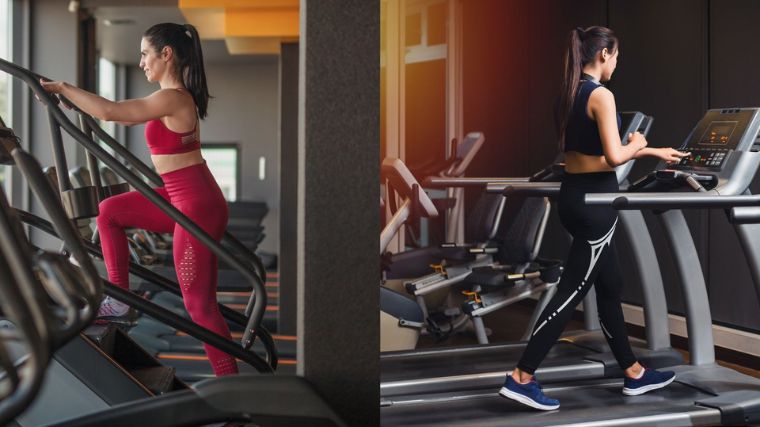
Here, we’ll break down the key differences and similarities between stair climbers and the treadmill, the pros and cons of each machine, and how to use both for some killer cardio exercise to boost your heart health and burn calories. Editor’s Note: The content on BarBend is meant to be informative in nature, but it should not be taken as medical advice. When starting a new training regimen and/or diet, it is always a good idea to consult with a trusted medical professional. We are not a medical resource. The opinions and articles on this site are not intended for use as diagnosis, prevention, and/or treatment of health problems. They are not substitutes for consulting a qualified medical professional.
- Key Differences
- Key Similarities
- What Is a StairMaster?
- The Benefits of the StairMaster
- The Cons of the StairMaster
- How to Use the StairMaster
- What Is a Treadmill?
- The Benefits of the Treadmill
- The Cons of the Treadmill
- How to Use a Treadmill
- Frequently Asked Questions
Key Differences
If you’re debating between a StairMaster workout and a treadmill workout, here are the differences you can expect.
- Type of Motion: On a stair stepper, you’ll perform a climbing motion, mimicking climbing stairs. On the treadmill, you can walk, jog, or run on a flat surface where you can adjust the incline.
- Learning Curve: The StairMaster can be challenging at first and takes some time to get used to — especially if you don’t hold on to the handrails. Beginners can use the treadmill immediately by simply walking.
- Muscle Engagement: Due to the climbing motion, stair climbers combine resistance training with cardio: it engages and strengthens your glutes. The treadmill works your quads, glutes, hamstrings, and calves as you walk or run but doesn’t strengthen them as much unless you’re pushing the intensity.
- Level of Impact: Some consider the StairMaster low-impact because you’re not pounding your feet, but it is arguably a lot of stress on your knees. The treadmill can be high-impact if you’re running or lower-impact if you’re walking.
Key Similarities
Although the motion is vastly different, here’s how the two pieces of equipment may be similar and can support your fitness goals.
- Boost Cardiovascular Health: Both machines provide an effective form of aerobic exercise that will raise your heart rate. Incorporating them into your workout program can improve your cardiovascular health and help prevent heart disease.
- Build Endurance: When you use them regularly, stair climbers and treadmills both can increase your endurance, aerobic capacity, and cardiovascular fitness.
- Burn Calories: Working out on either machine will help you burn calories and increase your total daily energy expenditure (TDEE). However, the number of calories may differ depending on how you use them.
- Home Gym Convenience: You can get a smaller stair climber or folding treadmill to fit into your home gym or office to help you get a cardio workout at home.
What Is a StairMaster?
The StairMaster is the brand name for a stair stepper. Generically, the machines are called stair climbers or stair steppers, with the terms often being used interchangeably. It’s a piece of cardio machine that looks like a small set of stairs with handrails on each side. The stairs continually revolve as you vertically climb them.
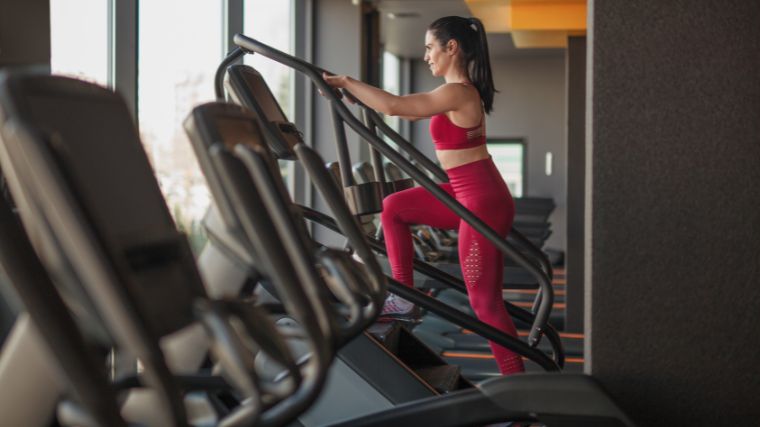
[Read More: The Best Online Workout Programs for Coaching, Cardio, Value, and More]
At the top of the stairs, there’s typically a control panel where you can adjust your speed and resistance or choose a pre-made workout. There may also be heart rate sensors, an entertainment screen, and an option to store your data so you can track progress over time.
The Benefits of the StairMaster
Stair climbers are unique in that you’ll be doing some resistance training while getting a great cardio workout. The aerobic aspect of using a stair stepper can benefit your physical and mental health. The way it uses multiple muscle groups makes it highly intense, providing muscle-strengthening benefits to your lower body and core. Let’s break it all down.
Aerobic Exercise Improves Your Physical and Mental Health
Cardio exercise refers to aerobic exercise. The American College of Sports Medicine (ACSM) defines aerobic exercise as a physical activity that uses large muscle groups and raises your heart rate and respiration, which you perform rhythmically for some time. Choosing a stair climber will do all of the above. (1)
Consistently doing cardio exercise is well-known to improve your cardiovascular health. Regular cardio regulates blood pressure and blood sugar, lowers cholesterol, and improves blood flow. It can boost your immune system and help you get better sleep. These benefits combine to improve your heart health and help prevent cardiovascular diseases. (2)(3)(4)
Cardio may also improve your mental health by helping to treat symptoms of depression and anxiety. It can boost your self-esteem, your mood, and self-image. It may help you lower your stress levels and cope with life’s challenges. (5)
High-Intensity Workout
The American Heart Association (AHA) provides physical activity guidelines to Americans through the United States Department of Health. The AHA recommends 150 to 300 minutes of moderate-intensity aerobic exercise, 75 to 150 minutes of vigorous-intensity exercise, or a combination of both per week. (6) Stair climbers often fall under the vigorous-intensity category.
The AHA defines vigorous intensity using the talk test: you should not be able to talk or hold a conversation while doing it. You can also measure it by your heart rate, which the Centers for Disease Control (CDC) lists as 77 to 93 percent of your maximum heart rate. You can get your maximum heart rate by subtracting your age from 220. Multiply your answer by the percentage to find your target heart rate. (7)
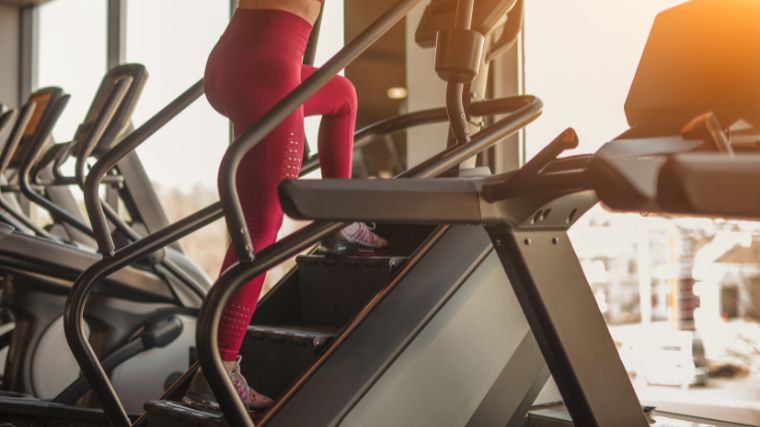
[Read More: What Are Workout Splits and Which Is the Best One?]
Stair climbers will get your heart rate up there no matter how fast you’re going because they work multiple muscle groups simultaneously. It’s a great option to include for a HIIT (high-intensity interval training) workout, where you alternate bursts of maximum effort with short rest periods.
Early research on the stair steppers states that stair-climbing motion doesn’t cause inertia or shock, which stresses your joints, muscles, and ligaments — making it a low-impact form of exercise. It’s a way to do high-intensity training without repeatedly hitting the surface you’re on. Instead, you take slow and controlled strengthening steps on the stairs. (8)
Strengthens Your Glutes
If you want to build your glutes, you need to perform resistance training outside of your cardio and eat enough calories to build muscle. But the stair climber is still a significant strength workout for your lower body muscles, and you’ll get some glute “activation” while you work your cardiovascular system.
As you climb onto the next stair, push through your heel and feel your glutes engage. When you straighten your leg on the next step, your glutes assist in extending your hip. This motion differs from the treadmill, where you walk or run on the same surface.
This extra glute work contributes to the high-intensity nature of the StairMaster and helps it raise your heart rate faster.
Works Your Core Muscles
Holding on to the handrails of the stair climber may seem tempting, but if you skip them, you’ll get an extra core workout. The handrails can be helpful if you’re new to this machine because they help support your upper body.
[Read More: Build a Titanic Torso with These Bodybuilding Chest & Back Workouts]
Using the stair climber without the handrails calls for you to engage your core to keep your spine straight as you get the intense lower-body work of climbing stairs. You’ll also work your upper body a bit to stay upright. It’s not quite an upper body workout, but by engaging more muscles, you raise your heart rate and increase the intensity of your StairMaster workout.
The Cons of the StairMaster
Stair climbers are excellent pieces of cardio machines because they require so much work, making them highly effective. However, all that work has some drawbacks if you have joint issues or are new to the gym.
Tough on Knees
The stair stepper may seem lower-impact than running because you’re not shocking your joints as you repeatedly hit the pavement or treadmill surface. (8)
However, the repetitive movement of climbing stairs can be tough on your knees. It may not be your best bet if you have joint pain, knee issues, or are recovering from a lower-body injury. The elliptical may be a better option because your feet stay planted the whole time.
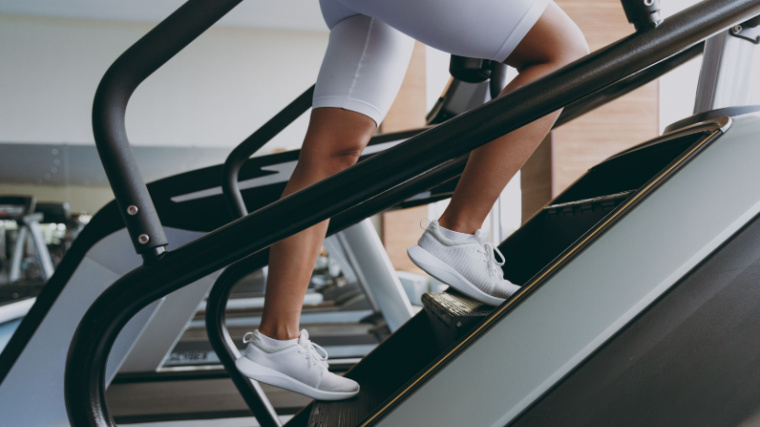
[Read More: The 8 Best Knee Sleeves You Can Buy]
However, if you’ve had knee issues in the past, stair climbers can help you get stronger. Your glutes assist in abducting your hips, which can help stabilize your knees. As you push through your heels and squeeze your glutes, your glute medius can assist in keeping your knees tracking out to prevent knee valgus.
Still, it can be difficult if your knees are prone to caving in, and repeatedly doing that on a stair climber can lead to more issues.
Difficult Learning Curve
As a beginner, it’s not as easy to hop onto a stair climber as it is to walk on a treadmill. Misusing the stepper can lead to joint pain and injury because of the repetitive motion of climbing stairs.
Holding onto the handrails when new to the StairMaster is okay, but you lose out on core engagement. A lack of core engagement can lead you to bend forward, keep your spine flexed while you work out, and put unnecessary strain on your lower back.
Beginners can use the StairMaster, of course. It takes some time to get used to and has a more demanding learning curve. They also might not be able to sustain the exercise long enough to get a maximally effective workout.
Climbing Stairs Only
Climbing stairs is great for your glutes and core and for quickly raising your heart rate in an intense workout. But climbing stairs is the only motion you can do on a stair climber. If you want to purchase cardio equipment for your home gym, you may want something more versatile.
You can’t use a stair stepper to train for an event or sport or mimic outdoor walking or running. You’ll get better at whatever you repeatedly do, so if you spend time climbing stairs, you’ll get better at climbing stairs. That’s not necessarily a bad thing, but something to remember.
How to Use the StairMaster
Here is a step-by-step breakdown of how to use a stair climber correctly and get the most out of your workout.
[Read More: The Ultimate 10-Week Powerbuilding Workout Routine for Mass and Strength]
- Step up onto the machine and start with a slow warm-up.
- Select your speed and resistance, or choose a pre-set workout.
- Stand tall, engage your core, and avoid leaning forward or holding onto the handrails. Push through your heels as you take your steps. Squeeze your glutes and keep your knees away from each other. Maintain your pace for 10 to 30 minutes.
- Reduce your speed and finish with a few minutes to cool down.
What You Need: Hop on the stair climber at the gym if you see one, though they’re not always in smaller gyms. Remember that StairMaster is a brand name — you can also use another brand’s version of a stair stepper or stair climber.
Setting Up: Always do a dynamic warm-up before beginning a stair climber workout. Finish with some cool-down stretches as well.
What Is a Treadmill?
A treadmill is a piece of cardio equipment that you use to walk, jog, run, or sprint in place. You can customize your speed and incline or choose from pre-set workouts. You can do these activities outdoors, but a treadmill lets you do them in a convenient indoor area where you don’t need to worry about weather or traffic.

[Read More: The 5 Best Fitness Trackers]
On the treadmill, you walk on a continually moving conveyor belt supported by the machine. You can increase your incline as desired. There are handrails to hold on to and a control panel to adjust your speed and incline. There are often heart rate monitors, an entertainment screen, and a system to keep track of your workouts so you can progress over time.
The Benefits of the Treadmill
The most significant benefit of treadmills over stair climbers is versatility. You can do more types of exercise with it and incorporate it into training programs for different goals. It’s also more adaptable for different intensities and fitness levels.
Versatile Intensity
On a treadmill, you can adjust your speed and incline to allow for any level of intensity you’re going for.
Keep the speed and incline low for a low-intensity walk as a warm-up before strength training or as a LISS cardio (low-intensity steady-state) workout on an active recovery day. You can also increase your incline but not your speed to increase intensity but not impact. Walking on the treadmill also allows for a more low-impact workout that can benefit people with joint pain.
On the other hand, you can also use the treadmill for high-intensity workouts. You can run, jog, and sprint as part of a HIIT workout or do some sprint workouts to finish off a lifting session with cardio.
Adaptable for All Fitness Levels
The treadmill has a (literally) lower barrier to entry than the stair climber. Beginners can get right on and take a walk, which may make it more feasible for people new to exercise to have the confidence to get moving.
Older folks or people recovering from injuries can benefit from the more straightforward learning curve. If you need weight-bearing cardio to strengthen your bones and help prevent osteoporosis, walking on the treadmill may be gentler on your knees than climbing stairs. (9)
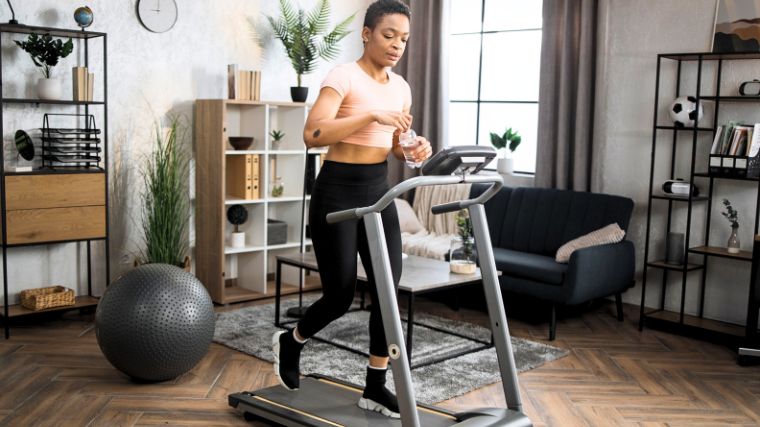
Advanced athletes who enjoy sprinting or running also benefit from using the treadmill. When you need to maintain a certain speed, it can be challenging to run outdoors if you don’t have a conducive area or the weather isn’t cooperating. You can customize your speed on the treadmill to stay at the exact pace you need.
Lower-Intensity Cardiovascular and Mental Health Benefits
Regularly incorporating the treadmill into your workout program will improve your cardiovascular health. Cardio exercise regulates your blood pressure, sugar, and cholesterol. It improves blood flow, boosts your heart health, and protects you from cardiovascular and metabolic diseases. (2)(6)
From the AHA’s guidelines for physical activity, you can use the treadmill to get both moderate-intensity and vigorous-intensity aerobic exercise. (2)(6)
Working out longer at a moderate heart rate trains your heart to deliver oxygen and blood more efficiently. This helps your heart work less hard in your daily life, reducing your risk of a heart attack. (10)
Research also shows that lower or moderate-intensity cardio exercise can have mental health benefits for people with clinical depression. With mild to moderate depression, exercise may have similar effects as medication and therapy. For severe depression, exercise can be a great addition to other treatments. (11)
People with severe depression may struggle to motivate themselves to exercise. Research shows that for depressed people with lower fitness levels, moderate-intensity exercise may be more enjoyable than high-intensity exercise, making them more likely to do it. Even a 10-minute, low-intensity walk can boost mood and reduce stress when living with depression. (12)
Train for an Event or Sport
If you’re prepping for a race or marathon, you can use the treadmill as part of your training program. It may not necessarily be better than running outdoors, but it works if you can’t get outside. You can adjust your speed and incline to reproduce the conditions you may face during your event.
Incorporating tempo runs into your program can train your body to run faster for longer. With tempo runs, you need to stay at a consistent intensity. Needing to slow down for an obstacle outdoors can decrease the effects of your workout, so they may be more effective on a treadmill where you can control all of the elements.
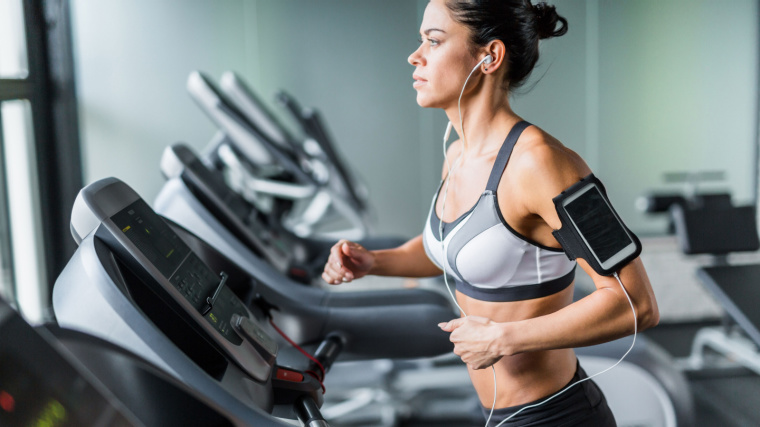
Hikers may also use the treadmill for steep incline walking to prepare for a big hike. It’s not the same as hiking, but you’ll work your muscles while building your endurance for uphill walking.
Athletes often incorporate sprints and treadmill runs as cross-training to help them build endurance and improve their performance in their sport.
The Cons of the Treadmill
Although the treadmill is more versatile than the stair climber, it requires more work to reach the same level of intensity you can hit when climbing stairs.
Cardio Exercise Only
You won’t necessarily be building muscle on the stair climber or the treadmill, but the climber has a little extra muscular engagement than the treadmill. You use your quadriceps, hamstrings, and calves on the treadmill to walk, jog, run, or sprint. Although your lower body muscles are working, they may not get much stronger, and it’s not a weightlifting exercise.
You can still use the treadmill in addition to resistance training. But depending on your treadmill workout, the stair machine may work your glutes more due to the motion of climbing up stairs.
Work Harder to Burn Calories
People often want to know which will give you a greater calorie burn when it comes to the stair climber versus the treadmill. You can burn calories on both machines, but you may need to work harder on the treadmill to reach the same intensity and expend the same amount of energy.
Two studies on college students compared heart rate and oxygen uptake when using a stair climber and running on the treadmill. In both cases, the results were comparable. The results led researchers to state that stair climbing and running on the treadmill are equally effective at raising your heart rate and improving oxygen uptake. (13)(14)
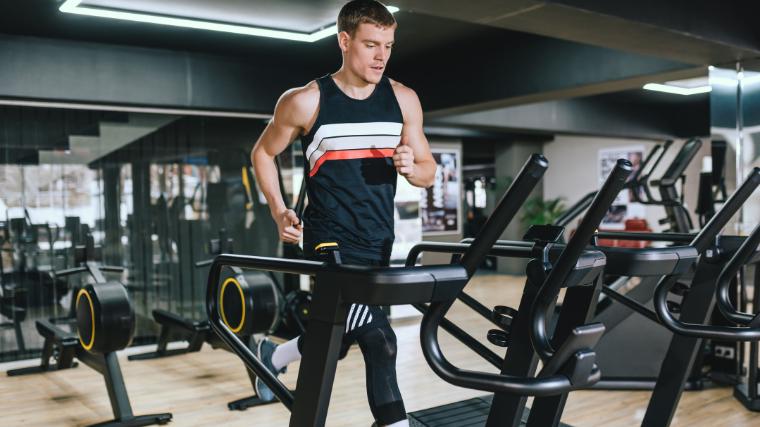
Stair climbing and running on the treadmill may burn similar calories — but walking on the treadmill is less intense and may not yield the same results. Walking at a moderate intensity has other benefits outside of burning calories. If burning calories is your primary goal, you’ll need to work faster and longer on the treadmill to expend the same energy you would on the stair climber.
Running is High-Impact
Running isn’t for everyone. It’s high-impact and places a lot of stress on your joints. Some people don’t enjoy it. If you’re not into running but want to get an equal amount of intensity as you would on the stair master, you’ll need to walk at an incline for longer.
How to Use a Treadmill
Get ready to walk, jog, run, or sprint. Here are the simple steps to using the treadmill.
[Read More: 5 At-Home Workouts for Strength, Muscle Growth, Power, and More]
- Step onto the treadmill. Begin with an easy walk or jog as a warm-up.
- Choose your speed and incline, or select a pre-set workout. Engage your core and stay tall through your spine and chest as you increase your intensity.
- Avoid holding the handrails for a more intense workout. Continue for your desired length of time.
- Decrease your speed and incline at the end of your workout, and finish with a few minutes of a slower jog or walk.
What You Need: Luckily, you can find treadmills in most gyms. You can even get a small treadmill or walking pad for your home.
Setting Up: Complete a dynamic warm-up before hopping on the treadmill to prepare your joints and muscles. Finish with some cool-down stretches.
Stepping Up
The StairMaster versus the treadmill — a classic cardio match-up. Both are powerful cardio equipment that you can use to build endurance, improve your cardiovascular health, and increase your energy expenditure for body recomposition goals.
Stair climbers can offer higher intensities with lower impact. However, they have a higher learning curve and are less versatile in intensity and types of workouts. Treadmills are more adaptable to different fitness levels, intensities, and forms of exercise. But if you’re not a runner, you may need to work harder and longer on it to burn the same amount of calories as the stair climber.
Both machines can support any fitness goal — be specific in what you’re looking to get out of your cardio workout, and hop onto the best machine for you.
FAQs
Here, we’ll answer some frequently asked questions in the battle of the StairMaster versus the treadmill.
Is StairMaster or treadmill better for weight loss?
Both machines (of any brand) can potentially help you lose body fat. If you want to reach a higher intensity without running, the stair climber may be a better fit.
There is some evidence that walking at a lower intensity may help your body tap into burning fat as an energy source, while high-intensity exercise uses glycogen. However, you’ll have to walk for a longer amount of time than you would spend on the stair climber. (15)
What is the difference between StairMaster and a treadmill?
A StairMaster is a vertical machine where you continually climb a revolving set of stairs. The treadmill is a flat conveyor belt where you can walk, jog, run, or sprint in place. Both machines allow you to adjust the speed. You can increase the incline on the treadmill.
Which is better for building muscle?
Neither machine is primarily designed for people to gain muscle mass. To build muscle, you need to do resistance training and eat enough calories and protein to be in a surplus. However, stair climbers may offer more muscle engagement at lower intensities, as you need to use your glutes to assist the stair-climbing motion — even when you’re moving slowly.
References
- Patel H, Alkhawam H, Madanieh R, Shah N, Kosmas CE, Vittorio TJ. Aerobic vs anaerobic exercise training effects on the cardiovascular system. World J Cardiol. 2017 Feb 26;9(2):134-138.
- Nystoriak MA, Bhatnagar A. Cardiovascular Effects and Benefits of Exercise. Front Cardiovasc Med. 2018 Sep 28;5:135.
- Nieman DC, Wentz LM. The compelling link between physical activity and the body’s defense system. J Sport Health Sci. 2019 May;8(3):201-217.
- Banno M, Harada Y, Taniguchi M, Tobita R, Tsujimoto H, Tsujimoto Y, Kataoka Y, Noda A. Exercise can improve sleep quality: a systematic review and meta-analysis. PeerJ. 2018 Jul 11;6:e5172.
- Sharma A, Madaan V, Petty FD. Exercise for mental health. Prim Care Companion J Clin Psychiatry. 2006;8(2):106.
- Piercy, K. L., & Troiano, R. P. (2018). Physical Activity Guidelines for Americans From the US Department of Health and Human Services. AHA Journal, 11(11).
- CDC. Target Heart Rate and Estimated Maximum Heart Rate. Centers for Disease Control and Prevention.
- Luketic, Ruth; Hunter, Gary R.; Feinstein, Carol. Comparison of StairMaster and Treadmill Heart Rates and Oxygen Uptakes. Journal of Strength and Conditioning Research 7(1):p 34-38, February 1993.
- Benedetti MG, Furlini G, Zati A, Letizia Mauro G. The Effectiveness of Physical Exercise on Bone Density in Osteoporotic Patients. Biomed Res Int. 2018 Dec 23;2018:4840531.
- Tian D, Meng J. Exercise for Prevention and Relief of Cardiovascular Disease: Prognoses, Mechanisms, and Approaches. Oxid Med Cell Longev. 2019 Apr 9;2019:3756750.
- Jan Knapen, Davy Vancampfort, Yves Moriën & Yannick Marchal (2015) Exercise therapy improves both mental and physical health in patients with major depression, Disability and Rehabilitation, 37:16, 1490-1495.
- Craft LL, Perna FM. The Benefits of Exercise for the Clinically Depressed. Prim Care Companion J Clin Psychiatry. 2004;6(3):104-111.
- Loy SF, Holland GJ, Mutton DL, Snow J, Vincent WJ, Hoffmann JJ, Shaw S. Effects of stair-climbing vs run training on treadmill and track running performance. Med Sci Sports Exerc. 1993 Nov;25(11):1275-8.
- George J. Holland, James J. Hoffmann, William Vincent, Mark Mayers & Ann Caston (1990) Treadmill vs Steptreadmill Ergometry, The Physician and Sportsmedicine, 18:1, 79-85.
- American Council on Exercise. HIIT vs. Steady State Cardio: Which One is Best for Your Clients? ACE Fitness.
Featured Image: Thammachak Sotiya & Max kegfire / Shutterstock